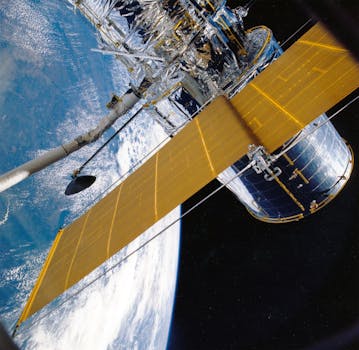From Geostationary to Low Earth Orbit: The Evolution of Satellite Telecommunications in 2023
The satellite telecommunications industry has undergone significant transformations in recent years, shifting from traditional geostationary orbits to low Earth orbits. This evolution has brought about numerous benefits, including improved connectivity, increased efficiency, and reduced costs.

From Geostationary to Low Earth Orbit: The Evolution of Satellite Telecommunications in 2023
The satellite telecommunications industry has witnessed a paradigm shift in recent years, with the transition from traditional geostationary orbits to low Earth orbits. This shift has been driven by advancements in space technology, growing demand for global connectivity, and the need for more efficient and cost-effective solutions. In this article, we will delve into the evolution of satellite telecommunications, exploring the benefits and challenges of this transition, as well as the current state of the industry.
Introduction to Satellite Telecommunications
Satellite telecommunications have been a crucial component of the global communication infrastructure for decades. Satellites in geostationary orbit, approximately 36,000 kilometers above the equator, have provided a wide range of services, including television broadcasting, telecommunications, and navigation. However, the limitations of geostationary orbits, such as high latency and limited bandwidth, have driven the development of new satellite technologies.
The Rise of Low Earth Orbit Satellites
Low Earth orbit (LEO) satellites, which orbit the Earth at an altitude of around 160-2,000 kilometers, have emerged as a game-changer in the satellite telecommunications industry. LEO satellites offer several advantages over traditional geostationary satellites, including lower latency, higher bandwidth, and improved connectivity. The reduced distance between LEO satellites and the Earth’s surface enables faster data transmission, making them ideal for real-time applications such as video streaming, online gaming, and virtual meetings.
Companies like SpaceX, OneWeb, and Amazon’s Kuiper Systems are leading the charge in the development of LEO satellite constellations. These constellations comprise hundreds or even thousands of satellites, working together to provide global coverage and high-speed connectivity. The launch of these constellations has sparked a new era of competition in the satellite telecommunications industry, driving innovation and reducing costs.
Benefits and Challenges of the Evolution
The shift from geostationary to LEO satellites has brought about numerous benefits, including improved connectivity, increased efficiency, and reduced costs. LEO satellites enable the provision of high-speed internet services to remote and underserved communities, bridging the digital divide and fostering economic growth. The lower latency and higher bandwidth of LEO satellites also make them suitable for applications such as IoT, autonomous vehicles, and smart cities.
However, the evolution of satellite telecommunications also presents several challenges. The deployment of LEO satellite constellations requires significant investment, and the management of thousands of satellites in orbit poses complex logistical and regulatory challenges. The risk of space debris and the potential for interference with other satellite systems are also concerns that need to be addressed.
Conclusion and Future Outlook
In conclusion, the evolution of satellite telecommunications from geostationary to LEO orbits has transformed the industry, enabling the provision of faster, more efficient, and cost-effective connectivity services. As the demand for global connectivity continues to grow, the development of LEO satellite constellations is expected to play a critical role in meeting this demand. While challenges persist, the benefits of this evolution far outweigh the drawbacks, and the future of satellite telecommunications looks promising.
